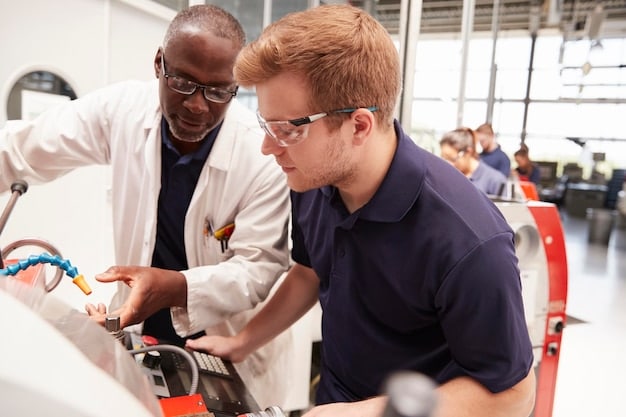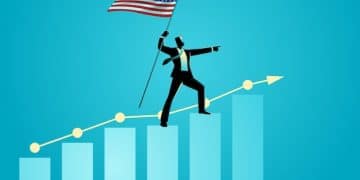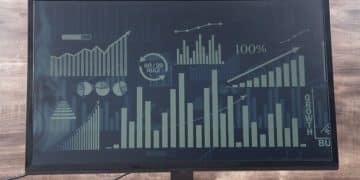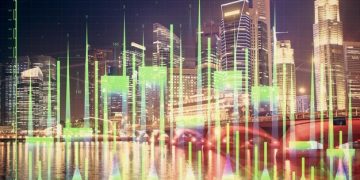US Job Creation: Decoding 2.8% GDP Growth in 2025

A projected 2.8% GDP growth in the US for 2025 could significantly boost job creation across various sectors, driven by increased consumer spending and business investment, although the precise impact will hinge on labor market dynamics and policy interventions.
As the global economy navigates a complex recovery, discussions around future economic indicators are gaining significant traction. A key projection for the United States economy in 2025 is a 2.8% GDP growth. This forecast sparks crucial questions about its potential impact on a cornerstone of economic stability: job creation. What does this number truly signify for the American workforce, and how might it reshape the employment landscape?
Understanding GDP Growth and Its Connection to Employment
Gross Domestic Product (GDP) is a fundamental measure of a nation’s economic output, reflecting the total monetary value of all finished goods and services produced within a country’s borders over a specific period. When GDP grows, it generally signals an expanding economy, suggesting increased production, consumption, and investment across various sectors. This expansion often translates into a greater demand for labor, subsequently fostering job creation.
However, the relationship between GDP growth and job creation is not always linear or immediate. Several factors can influence how efficiently economic growth translates into new jobs, including technological advancements, labor market rigidities, and the specific sectors driving the growth. A 2.8% GDP growth projection for 2025 in the US is considered robust, indicating a healthy economic trajectory that could significantly influence employment.
The mechanics of economic expansion
Economic expansion fundamentally relies on several pillars: consumer spending, business investment, government spending, and net exports. Each of these components, when growing, necessitates a larger workforce. For instance, increased consumer demand for goods and services directly encourages businesses to expand their operations, hiring more staff. Similarly, businesses investing in new facilities or technologies will require workers for construction, installation, and subsequent operation.
- 📈 Consumer Demand: Drives production, requires more sales and service personnel.
- 🏭 Business Investment: Fuels expansion, creates jobs in construction, manufacturing, and R&D.
- 🏛️ Government Spending: Public projects and services create jobs directly and indirectly through contractors.
- 🌐 Net Exports: A stronger export market can boost manufacturing and logistics employment.
Understanding these underlying mechanisms is crucial for appreciating how a 2.8% GDP growth forecast isn’t just an abstract number, but a direct indicator of potential increased activity across the economy, leading to a ripple effect on employment.
When the economy experiences healthy growth, businesses typically feel more confident about future demand. This confidence often leads to strategic decisions to expand operations, innovate, and enter new markets. Each of these actions, from opening a new factory to launching a new product line, requires human capital, thus directly contributing to job creation. Moreover, a stronger economy generally results in higher tax revenues, enabling governments to invest more in public services and infrastructure, which also generates employment opportunities. The 2.8% projected growth suggests a positive feedback loop is likely to be established, where growth begets more growth and, crucially, more jobs.
Sector-Specific Impacts: Where Will the Jobs Emerge?
While an overall GDP growth of 2.8% bodes well for job creation, the impact will likely be uneven across different economic sectors. Analyzing which industries are poised for the most significant expansion provides a more granular understanding of future employment trends. Historically, certain sectors are more sensitive to economic upturns, while others respond to long-term demographic or technological shifts.
The US economy in 2025 is expected to see strong growth in areas driven by technological innovation, sustainability, and persistent consumer demand. Anticipating these shifts allows both job seekers and policymakers to prepare for the evolving landscape, ensuring a skilled workforce is available to meet emerging needs. This detailed view helps in strategic planning for education, training, and workforce development initiatives.
Technology and innovation as growth drivers
The technology sector continues to be a powerhouse of job creation, characterized by rapid innovation and a constant demand for specialized skills. With a 2.8% GDP growth, enhanced business investment will likely flow into areas like artificial intelligence, cybersecurity, cloud computing, and advanced manufacturing. These fields not only create direct jobs for engineers, developers, and data scientists but also generate ancillary positions in sales, marketing, and support roles within tech companies.
- 💻 Software Development: Continued demand for new applications, platforms, and AI solutions.
- 🔒 Cybersecurity: Growing need for professionals to protect data and infrastructure from evolving threats.
- 🤖 Advanced Manufacturing: Integration of automation and robotics creates roles for skilled technicians and operators.
Beyond the tech sector itself, technological advancements permeate almost every other industry, reshaping roles and creating new opportunities. For instance, digital transformation initiatives in retail, healthcare, and finance require IT specialists, project managers, and data analysts, further broadening the scope of tech-related job growth.
Healthcare and education: foundational pillars
These two sectors consistently contribute to employment growth, often driven by demographic changes and ongoing societal needs. An aging population in the US fuels continuous demand for healthcare services, from direct patient care to research and development. Similarly, the evolving educational landscape, from early childhood to higher education and workforce training, requires a steady influx of educators, administrators, and support staff.

Expected GDP growth will enable further investment in these crucial sectors, leading to job creation in hospitals, clinics, research institutions, and educational facilities. This growth is often more stable and less cyclical than in other economic areas, providing a steady source of employment.
Additionally, the push towards personalized medicine and online learning platforms signifies a hybrid growth model, blending traditional service provision with technological integration. This dual approach ensures that even as new technologies emerge, the foundational human element of care and instruction remains paramount, expanding the types of roles available within these sectors. Hence, job creation here is not just about quantity but also about diversification and specialization.
Challenges and Caveats: Factors Influencing Job Creation
While a 2.8% GDP growth forecast is inherently positive, it’s essential to acknowledge the potential challenges and caveats that could influence the actual rate and quality of job creation. Economic models are intricate, and real-world outcomes can be swayed by a multitude of external and internal factors. Understanding these nuances is key to a balanced perspective on the future employment landscape.
From inflationary pressures to global economic instability and the pace of technological adoption, various elements can either accelerate or decelerate the translation of economic growth into new jobs. Policymakers and businesses must remain agile, adapting strategies to mitigate risks and capitalize on opportunities presented by these dynamic forces. The precision of how how will the projected 2.8% GDP growth in 2025 impact US job creation hinges significantly on these variables.
Inflationary pressures and interest rates
Significant economic growth, if not managed carefully, can lead to inflationary pressures. High inflation erodes purchasing power, potentially dampening consumer demand and increasing operating costs for businesses. Central banks typically respond to persistent inflation by raising interest rates, which can slow down economic activity by making borrowing more expensive for both consumers and businesses. This, in turn, can curb investment and hiring intentions.
Therefore, while a 2.8% GDP growth is desirable, its impact on job creation will depend on whether it can be achieved without triggering excessive inflation or requiring aggressive monetary tightening. A balanced approach from fiscal and monetary authorities will be critical to sustain growth and facilitate robust job gains without overheating the economy.
Technological displacement vs. creation
Technological advancements, particularly in automation and artificial intelligence, present a dual challenge. While they undoubtedly create new highly skilled jobs in innovation and maintenance, they also possess the potential to displace workers in routine or repetitive tasks. The net effect on overall job creation depends on the pace of displacement versus the rate of new job creation and the effectiveness of workforce retraining initiatives.
- 🤖 Automation Risks: Certain manufacturing, administrative, and service roles are vulnerable to automation.
- 💡 New Skill Demand: Growth in AI, data science, and green technologies requires upskilling and reskilling.
- 📚 Retraining Imperative: Educational systems and governments must support workers in transitioning to new roles.
Ensuring that the workforce can adapt to technological shifts is crucial. Policies that support education, vocational training, and lifelong learning can mitigate the negative impacts of technological displacement and maximize the job-creating potential of innovation. The challenge lies in managing this transition equitably, ensuring that the benefits of technological progress are widely shared rather than concentrated.
Furthermore, global economic uncertainties, such as geopolitical tensions, supply chain disruptions, or unforeseen health crises, can significantly alter economic forecasts. The US economy does not operate in a vacuum; external shocks can quickly shift investment patterns and consumer confidence, directly influencing hiring decisions. Businesses are increasingly wary of these external factors, often adopting a cautious approach to expansion even during periods of domestic growth. Therefore, even with a strong GDP projection, the global economic climate will play a considerable role in shaping the final job creation figures in 2025.
Policy Levers: Government’s Role in Maximizing Job Growth
Government policies play a pivotal role in shaping how economic growth translates into employment opportunities. Beyond the intrinsic forces of the market, deliberate policy decisions can either amplify or dampen job creation. With a projected 2.8% GDP growth, understanding the policy levers available to maximize this potential is crucial for ensuring widespread prosperity and a robust labor market.
Policymakers have a range of tools at their disposal, from fiscal incentives to regulatory frameworks and investments in public goods. The effectiveness of these interventions often lies in their strategic design and timely implementation, aiming to foster an environment where businesses can thrive and individuals are equipped with the skills needed for future jobs. This proactive approach is vital to convert economic forecasts into tangible employment gains across the nation.
Fiscal measures and investment incentives
Fiscal policies, including taxation and government spending, are powerful instruments for stimulating job creation. Tax incentives for businesses that invest in expansion, research & development, or green technologies can directly encourage hiring. Similarly, government investment in infrastructure projects—such as roads, bridges, and broadband internet—creates numerous jobs in construction, engineering, and related industries while also improving the foundational environment for private sector growth.
Moreover, targeted subsidies or grants for small businesses, often considered the engines of job creation, can help them scale operations and onboard new employees. These fiscal measures aim not only to spur economic activity but also to direct growth towards job-intensive sectors, ensuring that the benefits of GDP expansion are widely distributed across the workforce.
Workforce development and education initiatives
A critical challenge in modern economies is the mismatch between available skills and the demands of emerging industries. Governments can address this through robust workforce development programs, including vocational training, apprenticeships, and partnerships with educational institutions. Investing in education and reskilling initiatives ensures that the labor force can adapt to technological changes and meet the needs of growth sectors.

- 🎓 Skill Matching Programs: Bridging the gap between employer needs and worker capabilities.
- 🛠️ Vocational Training: Equipping workers with practical skills for high-demand trades and technical jobs.
- 🤝 Apprenticeships: Combining on-the-job training with classroom instruction, fostering immediate employment.
These initiatives are particularly important for enabling smoother transitions for workers potentially displaced by automation and for ensuring that the US workforce remains competitive globally. By investing in human capital, the government helps to build a resilient labor market capable of harnessing the benefits of economic growth for sustained job creation.
Furthermore, regulatory frameworks play a subtle yet significant role. While some regulations are essential for worker protection and environmental sustainability, overly burdensome or complex regulations can stifle business growth and deter investment, thus hindering job creation. Striking the right balance is key: ensuring a safe and fair operating environment while also fostering an atmosphere conducive to innovation and business expansion. Streamlined permitting processes, clear legal guidelines, and predictable enforcement can significantly contribute to business confidence, encouraging companies to invest and hire. The goal is to craft a regulatory landscape that champions both public interest and economic dynamism, directly supporting the translation of GDP growth into new jobs.
The Role of Consumers and Businesses in Job Market Dynamics
Beyond government actions, the collective behavior of consumers and businesses forms the bedrock of job market dynamics. Their confidence levels, spending habits, and investment strategies intricately weave together to determine how effectively a projected 2.8% GDP growth translates into tangible employment gains. Understanding these drivers is essential for a holistic view of future job creation.
In a market economy, decisions made by millions of individuals and thousands of companies aggregate to create broad economic trends. When consumers are optimistic about their financial future, they spend more, and when businesses anticipate strong demand, they invest and expand. This symbiotic relationship is crucial for converting macroeconomic indicators like GDP growth into microeconomic realities, such as new hires.
Consumer confidence and spending
Consumer spending is the largest component of GDP in the US, making consumer confidence a critical driver of economic growth and job creation. When consumers feel secure in their jobs and optimistic about their future earnings, they are more likely to spend on goods and services, from everyday necessities to discretionary items like travel and entertainment. This increased demand directly prompts businesses to produce more, which in turn necessitates hiring additional staff to meet the production and service requirements.
A sustained 2.8% GDP growth would likely be supported by strong consumer confidence, creating a positive feedback loop where economic growth fuels spending, and spending further stimulates growth and job opportunities. High employment rates themselves contribute to consumer confidence, creating a virtuous cycle.
Business investment and expansion decisions
Businesses react to perceived economic opportunities by investing in capital, technology, and human resources. When a robust GDP growth of 2.8% is forecast, companies are more inclined to expand their operations, innovate, and enter new markets. These activities almost invariably lead to increased hiring. Investment decisions often precede job creation, as businesses need employees to operate new facilities, develop new products, or manage expanded service offerings.
- 📈 Capital Expenditure: Investment in new machinery and infrastructure directly creates construction and manufacturing jobs.
- 🔬 R&D Spending: Fuels innovation, leading to jobs for scientists, engineers, and researchers.
- 🌍 Market Expansion: New geographic or product markets require additional sales, marketing, and operational staff.
The willingness of businesses to take risks and commit capital for future growth is a fundamental prerequisite for translating macroeconomic growth into tangible employment numbers. Factors such as access to affordable credit, a stable regulatory environment, and a skilled labor pool are paramount in influencing these investment and expansion decisions.
The interaction between consumer behavior and business strategy dictates much of the employment landscape. If businesses perceive a sustained demand fueled by confident consumers, they will be more aggressively seeking to expand their workforce. Conversely, if consumer spending slows, businesses may adopt a more cautious stance, potentially delaying hiring plans. Therefore, while a 2.8% GDP growth provides the economic fuel, the engine of job creation relies heavily on the synchronized and optimistic decisions made by both consumers and the broader business community. This interplay ensures that economic growth is not just a statistical phenomenon but a generator of real-world opportunities.
Long-Term Economic Health and Social Implications
Beyond the immediate numbers of job creation, a sustained 2.8% GDP growth in 2025 has profound implications for the long-term economic health and social fabric of the United States. High and stable employment levels contribute significantly to individual well-being, community vitality, and national competitiveness. The ripple effects extend far beyond economic metrics, touching on education, public health, and social equity.
A robust job market, fostered by healthy economic growth, underpins consumer confidence, reduces poverty, and strengthens the fiscal capacity of the government. This allows for greater investment in social programs and infrastructure, creating a positive cycle of development and improved quality of life. Understanding these broader implications helps situate the importance of job creation within a larger societal context.
Poverty reduction and social mobility
Job creation, especially in sectors that offer decent wages and career progression, is a primary driver of poverty reduction and enhanced social mobility. When more people are employed, and existing workers see their wages rise, families are better able to meet their basic needs, invest in education, and build savings for the future. This reduces reliance on social safety nets and fosters greater economic independence.
Furthermore, a thriving job market can stimulate a merit-based system where hard work and skill development are rewarded, providing pathways for individuals to move up the economic ladder. The 2.8% GDP growth projection suggests an environment conducive to these positive social transformations, potentially lifting many out of poverty and expanding the middle class.
Government revenues and public services
A healthy labor market and strong economic growth directly lead to increased government revenues through income taxes, payroll taxes, and corporate taxes. These additional funds provide governments at all levels with greater capacity to invest in critical public services. From education and healthcare to public infrastructure and scientific research, these investments improve the overall quality of life and support future economic growth.
- 🏥 Healthcare Access: Enhanced funding can improve public health systems and access to care.
- 🏫 Education Funding: Allows for better schools, more resources, and expanded educational opportunities.
- 🏗️ Infrastructure Development: Investments in transportation and utilities boost productivity and create jobs.
This virtuous cycle—where economic growth boosts employment, which in turn increases government revenues, leading to better public services and an even stronger economy—is a cornerstone of national development. The 2.8% GDP growth forecast represents an opportunity to strengthen this cycle, paving the way for more resilient communities and a more equitable society.
Moreover, the long-term health of an economy with steady job growth can bolster national security and international standing. A strong domestic economy provides the resources necessary for defense, diplomatic engagement, and humanitarian aid. It also projects an image of stability and opportunity, attracting foreign investment and skilled immigration, further contributing to innovation and economic vibrancy. Thus, the projected GDP growth and its associated job creation are not merely domestic concerns but also powerful determinants of the USA’s global influence and overall societal resilience in the face of future challenges. The ability to generate and sustain sufficient jobs is a litmus test for the success of broader national strategies.
Key Metrics and Future Economic Indicators
To accurately assess how the projected 2.8% GDP growth in 2025 will impact US job creation, it’s vital to monitor a range of key economic metrics and indicators. These data points provide a real-time snapshot of the labor market’s health and offer insights into the effectiveness of economic policies and business strategies. Relying solely on GDP figures can be misleading without considering the broader context of employment and demographic trends.
Tracking these indicators allows economists, policymakers, and businesses to make informed decisions, adapting to evolving conditions and ensuring that growth is inclusive and sustainable. Such vigilance is critical for understanding the qualitative aspects of job creation—not just how many jobs are being created, but what kind of jobs, and for whom. The holistic picture emerges from synthesizing various economic signals.
Unemployment rates and labor force participation
The unemployment rate is perhaps the most direct measure of job market health. A declining unemployment rate, coupled with a 2.8% GDP growth, would strongly suggest that the economy is creating jobs faster than new workers are entering the labor force or being displaced. However, it’s also important to consider the labor force participation rate, which indicates the percentage of the working-age population actively employed or seeking employment. A healthy job market should see both low unemployment and a stable or rising participation rate.
If GDP grows but participation rates stagnate or decline, it could indicate that growth is not broadly benefiting all segments of the population or that there are structural barriers to employment for certain groups. Analyzing these metrics together provides a clearer picture of employment trends than either one alone.
Wage growth and income distribution
Beyond the sheer number of jobs, the quality of employment is paramount. Wage growth and income distribution are critical indicators of how broadly the benefits of economic growth are being shared. Strong GDP growth should ideally translate into rising wages across various income brackets, particularly for middle and lower-income workers. This signifies a dynamic labor market where businesses are competing for talent, driving up compensation.
- 💰 Average Hourly Earnings: Tracks overall wage trends.
- 📉 Gini Coefficient: Measures income inequality, showing how evenly income is distributed.
- 👨👩👧👦 Median Household Income: Reflects the typical income level for American families.
If GDP growth occurs without significant corresponding wage increases for the majority, it could point to issues like labor market power imbalances or a disproportionate share of economic gains accruing to capital owners rather than workers. Therefore, monitoring wage growth alongside GDP is essential for assessing the overall impact on the living standards of the American populace.
Other important indicators include job vacancy rates, which reflect employer demand, and the duration of unemployment, indicating how long people are struggling to find work. Trends in sector-specific employment, particularly in emerging industries, also provide valuable insights into structural shifts in the economy. Furthermore, monitoring business sentiment and consumer confidence surveys can offer forward-looking perspectives that complement retrospective data. By integrating these diverse metrics, analysts can construct a comprehensive model of the US labor market’s response to the projected 2.8% GDP growth, allowing for more precise forecasting and strategic interventions.
| Key Aspect | Brief Description |
|---|---|
| 💰 GDP Growth & Jobs | 2.8% GDP growth signals economic expansion, generally leading to increased demand for labor and more job opportunities. |
| 🚀 Sector Focus | Technology, healthcare, and education are projected to be key sectors driving significant job creation. |
| ⚠️ Challenges Ahead | Inflation, interest rates, and technological displacement can influence how growth impacts job creation. |
| 🏛️ Policy Influence | Government fiscal measures and workforce development programs are crucial for maximizing employment gains. |
Frequently Asked Questions about 2025 US Job Growth
GDP growth generally means more economic activity, leading to increased business profits and investment. For average Americans, this often translates to more job opportunities, potentially higher wages, and greater consumer choice. It can also lead to improved public services as government tax revenues increase, enhancing overall living standards.
Key beneficiaries are typically sectors driven by innovation and essential services. This includes technology (AI, cybersecurity), healthcare (due to an aging population), and education (upskilling, reskilling). Construction and manufacturing might also see boosts from business investment and infrastructure projects, creating diverse job roles.
Yes, inflation can indeed dampen job creation. If inflation becomes too high, it erodes consumer purchasing power and increases business costs. Central banks might respond by raising interest rates, making borrowing more expensive, which can discourage business investment and expansion, thereby limiting new job opportunities despite GDP growth.
Government policies can support job creation through various means. These include fiscal incentives for businesses (tax breaks for R&D), investment in public infrastructure, and robust workforce development programs. Education and vocational training initiatives are crucial for ensuring the labor force has the skills demanded by growing industries.
Consumers play a dominant role. High consumer confidence leads to increased spending on goods and services, which directly drives demand for businesses. This demand, in turn, prompts companies to expand production and hire more employees. Without robust consumer spending, even strong GDP growth might not translate efficiently into widespread job creation.
Conclusion
The projected 2.8% GDP growth for the US in 2025 presents a largely optimistic outlook for job creation, signaling a robust and expanding economy. This growth trajectory is expected to fuel employment across diverse sectors, particularly in technology, healthcare, and education, driven by increased consumer demand and business investment. However, the exact magnitude and nature of job gains will undoubtedly be shaped by how effectively challenges such as inflation and technological shifts are managed. Proactive government policies, including targeted fiscal measures and comprehensive workforce development initiatives, will be instrumental in maximizing this potential. Ultimately, a sustained economic expansion, carefully guided by strategic planning and adaptive responses, promises to not only create more jobs but also to enhance long-term economic health and foster greater social mobility for all Americans.





